|
|
||||
|
Published by : PROFESSIONAL MEDICAL PUBLICATIONS |
||||
|
ISSN 1681-715X |
||||
|
||||
|
- |
||||
|
ORIGINAL ARTICLE |
||||
|
- |
||||
|
Volume 21 |
October December 2005 |
Number 4 |
||
|
|
||||
|
|
||||
Identification of drug resistance genes in
clinical isolates
of Salmonella typhi for development of diagnostic
multiplex PCR
Asma Haque1, Abdul Haque2, Yasra Sarwar3, Aamir Ali4,
Saira Bashir5, Ayesha Tariq6, Mushkoor Mohsin7
Abstract:
Background: Typhoid is one of the most common infectious diseases in the developing countries including Pakistan. In recent years, rapid emergence of multiple drug resistant (MDR) strains of Salmonella typhi has been a major problem.
Objectives: To develop a multiplex PCR method that can be subsequently improved in a second step to diagnose Salmonella typhi and genes responsible for causing resistance against commonly used anti typhoid drugs, i.e. chloramphenicol, ampicillin, sulphamethoxazole and ciprofloxacin.
Methods: Drug resistance patterns against the above mentioned drugs were determined by standard drug diffusion methods. Primers were synthesized to target various genes that could be responsible for the drug resistance. Amplicons indicating presence of gyrA gene which is responsible for ciprofloxacin resistance were obtained from resistant Escherichia coli strains and cloned into Salmonella typhi. The transformation was confirmed by sequencing.
Results: In 23 MDR isolates of Salmonella typhi tested by disc diffusion method against ciprofloxacin, chloramphenicol, co-trimoxazole, and ampicillin, resistance was observed in 0 (0%), 17 (73.9%), 17 (73.9%), and 22 (95.7%) isolates respectively. The genes responsible for drug resistance were identified to be catP (chloramphenicol), tem (ampicillin), and sul 2 (co-trimoxazole). An amplification product representing gyrA gene (ciprofloxacin resistance) was cloned and successfully transformed into a Salmonella typhi isolate (confirmed by amplification of fliC gene) showing resistance to other three drugs. Confirmation was obtained by sequencing. This transformed strain was used to develop a multiplex PCR that gave amplification products of 707(sul2) 623 (cat P) 363 (fliC) 313 (gyrA) and 311 (tem) bps respectively.
Conclusion: A multiplex PCR for simultaneous detection of Salmonella typhi and resistance against anti-typhoid drug has been successfully developed that can be easily improved for direct application on clinical samples.
Key Words: Salmonella typhi, Multiple Drug Resistance, Diagnosis, Multiplex PCR
Pak J Med Sci October-December 2005 Vol. 21 No. 4 402-407
1. Ms. Asma Haque M.Sc.
2. Dr. Abdul Haque PhD,
3. Ms. Yasra Sarwar M.Phil
4. Mr. Aamir Ali M.Phil
5. Ms. Saira Bashir M.Phil
6. Ms. Ayesha Tariq M.Phil
7. Mr. Mushkoor Mohsin M.Phil
1-7: Health Biotechnology Division,
National Institute for Biotechnology & Genetic Engineering (NIBGE),
P.O. Box: 577, Jhang Road,
Faisalabad, Pakistan
Correspondence:
Dr. Abdul Haque
E-mail: ahaq_nibge@yahoo.com
Received for publication: March 16, 2005
Accepted: June 25, 2005
INTRODUCTION
Typhoid fever is a major health concern in the developing world as it is found endemically throughout Africa, South America, East Asia and particularly in South Asia
1-5. It is an acute, systemic illness caused by infection with various serovars of Salmonella typhi.Emerging Multiple Drug Resistance (MDR) is a major problem in control of infectious diseases. In case of typhoid, MDR Salmonella typhi (Salmonella enterica serovar Typhi) strains are frequently associated with increased morbidity that leads to toxicity that ultimately results in significantly increased mortality rate.6-8
In Pakistan, MDR strains of Salmonella typhi were first reported in 1988 after being reported in India and Bangladesh. MDR isolation rate reached epidemic proportions during mid 90’s when simultaneous resistance to chloramphenicol, ampicillin and sulfonamides emerged
9,10. Ciprofloxacin is the drug of choice but resistance against it has been reported in Central Asia11 and recently in Karachi (personal communication).A continuous increase in multiple drug resistance against typhoid transpires the need for development of some effective method that can not only diagnose it at an early stage, but also determines the extent of drug resistance which will enable the clinician to suggest the suitable treatment. The current practice of blood culture followed by bacterial isolation, identification and drug resistance determination by disc diffusion method takes at least one week which is unacceptable12. During the last decade, introduction of molecular methods especially PCR have proved to be rapid, sensitive and specific for routine diagnosis of typhoid13,14. In this regard, multiplex PCR targeting specific genes can be even more useful for rapid and efficient diagnosis of MDR strains of Salmonella typhi.
MATERIALS & METHODS
Isolation and identification of MDR Salmonella typhi strains: Twenty three strains of multiple drug resistant Salmonella typhi were taken from patients suffering from typhoid fever. These samples were collected from different hospitals in Faisalabad, Rawalpindi and Karachi. These strains were revived in Trypticase Soy Broth and cultured on MacConkey agar to get typical colonies for each strain. Biochemical identification was carried out by inoculating the colonies on Triple Sugar Iron (TSI) medium. Drug sensitivity pattern of each strain was obtained by disc diffusion test (NIH, USA) and those strains were selected for further studies that exhibited maximal resistance to the commonly used antityphoid drugs.
PCR amplification of resistance genes: DNA extraction of the selected strains was carried out by using conventional chloroform/ phenol method15. Molecular confirmation of Salmonella typhi strains was made by targeting fliC gene by PCR18. Various primer sets (Table-I) were employed for targeting specific sequences in the resistance genes, if present in the DNA samples. Conditions were optimized for amplification of each sequence.
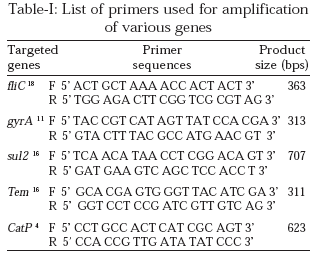
Cloning of a gyrA gene fragment from Escherichia coli into Salmonella typhi: In order to introduce resistance against ciprofloxacin in Salmonella typhi, a segment of gyrA gene present in a ciprofloxacin resistant clinical isolate of Escherichia coli was amplified and cloned into a Salmonella typhi strain which was already resistant to all other antityphoid drugs. Transformation was confirmed by sequencing. Cloning was done by using PCR Product Cloning Kit # K1214 (Fermentas). Sequencing was got done through a commercial vendor.
PCR conditions for confirmation of Salmonella typhi (fliC gene): 100 µl DNA amplification mixture contained 10 mM Tris HCl (pH 8.3), 50 mM KCl, 1.5 mM MgCl2, 0.01% gelatin, 150 pmol of each primer, 95 nmol of each dNTP, 5 units of Taq (Fermentas), 20 µl of template and distilled water to make up the volume .
Thermocycler conditions were 30 cycles of one minute each at 94°C, 63°C and 72°C followed by heating at 72°C for 7 minutes.
PCR conditions (sul2): 100 µl DNA amplification mixture contained 10 mM Tris HCl (pH 8.3), 50 mM KCl, 1.5 mM MgCl2, 0.01% gelatin, 150 pmol of each primer, 95 nmol of each dNTP, 5 units of Taq (Fermentas), 20µl of template and distilled water to make up the volume. Thermocycler conditions were 30 cycles of 1 minute each at 94°C, 50°C and 72°C followed by heating at 72°C for 7 minutes.
PCR conditions (catP, tem): 100 µl DNA amplification mixture contained 10 mM Tris HCl (pH 8.3), 50 mM KCl, 1.5 mM MgCl2, 0.01% gelatin, 120 pmol of each primer, 95 nmol of each dNTP, 3.75 units of Taq (Fermentas), 20µl of template and distilled water to make up the volume. Thermocycler conditions were 30 cycles of 45 sec each at 94°C, 50°C and 72°C followed by heating at 72°C for 7 minutes.
PCR conditions (gyrA): 100µl DNA amplification mixture contained 10 mM Tris HCl (pH 8.3), 50 mM KCl, 1.5 mM MgCl2, 0.01% gelatin, 150 pmol of each primer, 95 nmol of each dNTP, 4 units of Taq (Fermentas), 20 µl of template and distilled water to make up the volume. Thermocycler conditions were
30 cycles of 1 minute each at 94°C, 60°C and 72°C followed by heating at 72°C for 7 minutes.
Development of multiplex PCR: Transformants were confirmed through amplification of fliC and gyrA genes. Thermocycler and reaction conditions were then optimized for the simultaneous amplification of all the drug resistance genes, i.e, gyrA, catP, tem and sul2 alongwith fliC gene in a single reaction.
PCR conditions for multiplex PCR (fliC, gyrA, tem, sul2 and catP genes): 100 µl DNA amplification mixture contained 10 mM Tris HCl (pH 8.3), 50 mM KCl, 1.5 mM MgCl2, 0.01% gelatin, 120 pmol of each primer, 95 nmol of each dNTP, 3.75 units of Taq (Fermentas), 20 µl of template and distilled water to make up the volume .
Thermocycler conditions were 4 min at 940C, 30 cycles each at 94°C (1.5 min), 45°C(1 min) and 72°C(2 min) followed by 5 min at 72°C.
RESULTS
Drug resistance pattern by disc diffusion method: The results are summarized in Table-II. It is noticeable that all strains were sensitive to ciprofloxacin and all but one were resistant to ampicillin. Majority (17 each) were resistant to ciprofloxacin and chloramphenicol as well. Eleven of these strains were resistant to all drugs except ciprofloxacin.

Determination of drug resistance pattern by targeting specific genes by PCR: After confirmation by fliC gene amplification, conditions were optimized for amplification of sul2, tem and catP genes (Fig 1a, 1b, 1c, and 1d). As there was no Salmonella typhi strain resistant to ciprofloxacin, no amplification could be obtained for the required sequence of gyrA gene.
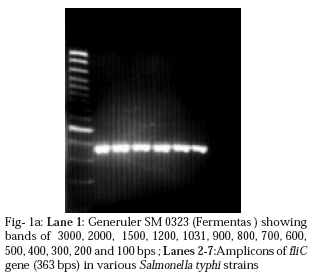 |
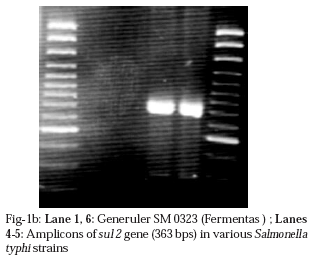 |
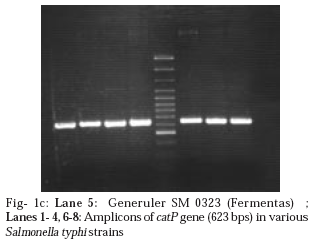 |
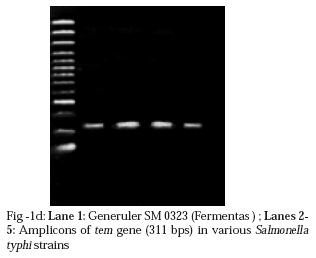 |
Cloning of PCR amplifiable segment of gyrA gene into Salmonella typhi from E.coli: Specific primers were used to amplify a 313 bp segment of gyrA gene from DNA of a ciprofloxacin resistant strain of Escherichia coli. This sequence was introduced into an MDR Salmonella typhi strain that was resistant to ampicillin, chloramphenicol and co-trimoxazole. Successful transformation was confirmed by sequencing of the transformed product. The resultant clone contained PCR amplifiable segments representing genes conferring resistance to all four major typhoid drugs (Fig 2). Using this strain, conditions were optimized for the development of a multiplex PCR. The results are shown in Fig 3.
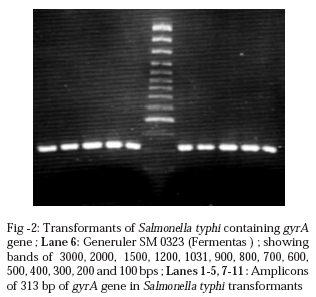
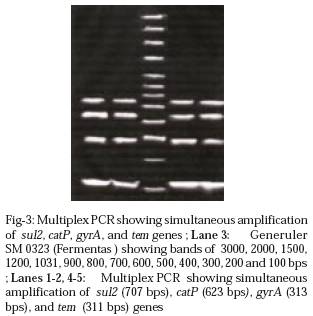
DISCUSSION
With the emergence and continual increase in the multiple drug resistance, determination of drug resistance along with the timely diagnosis of typhoid has become a matter of vital importance.
Blood culture is the only method that is routinely used for determination of drug resistance in typhoid patients. The results are obtained after nearly one week, therefore the early detection of disease is not possible. Another major disadvantage is that its detection rate is only about 30%. It is attributed to various factors like previous administration of antibiotics to the patient
12. This transpires the need for development of some effective method that can not only diagnose typhoid at an early stage, but also provide information to enable the physician to start focused treatment from the onset of disease. Cost effectiveness of the method is also an important feature, which should be comparable to the existing methods.Molecular methods can provide a major breakthrough in this regard. PCR for rapid and sensitive and specific diagnosis of typhoid has already been developed13,18,19. We envisaged that a multiplex PCR targeting specific genes related to diagnosis and drug resistance would be very useful. We worked in this direction and have been able to develop a multiplex PCR that can be used for diagnosis of typhoid and determination of drug resistance pattern of the particular strain.
After identifying the genes that are responsible for drug resistance to drugs used for treatment of typhoid, we optimized PCR conditions for simultaneous amplification of specific Salmonella typhi fliC gene and all relevant drug resistance genes so that the result could be obtained in a single experiment. It would provide information on diagnosis and drug resistance pattern in a single day.
Our method can differentiate between different genes very easily except for tem and gyrA genes which are too closely placed (311 bps and 313 bps) to be distinguished. We are working on a nested PCR which will resolve this problem and increase sensitivity level to a degree so that this assay is directly applicable to clinical samples.
Financial Support:
Funds for this research were supplied by National Institute for Biotechnology and Genetic Engineering, Faisalabad, Pakistan.
REFERENCES
1. Thong K, Cheong Y, Puthucheary S, Koii CL, PangT. Epidemiological analysis of spdoradic Salmonella typhi isolates and those from outbreaks by pulse-field gel electrophoresis J Clin Microbiol 1994; 32: 1135-41.
2. Gilman RH, Terminel M, Levine MM, Hernandez-Mendoza P, and Hornick RB. Relative efficacy of blood, urine, rectal swab, bone-marrow, and rose-spot cultures for recovery of Salmonella typhi in typhoid fever Lancet 1975; 1211-13.
3. Rockhill RC, Rumans LW, Lesmana M, and Dennis DT. Detection of Salmonella typhi D, Vi, and d antigens, by slide coagglutination, in urine from patients with typhoid fever. J Clin Microbiol 1980; 11: 213-16.
4. Beatriz G, Soto SM, Argüelles JM, and Mendoza MC. Multidrug resistance is mediated by large plasmids carrying a Class 1 Integron in the emergent Salmonella enterica serotype Antimicrobial Agents Chemotherapy 2001; 45: 1305-98
5. Avendano A, Herrera P, Horwitz I, Duarte E, Prenzel I, Lanata C, and Levine ML. Duodenal string culture: practicality and sensitivity for diagnosing enteric fever in children. J Infect Dis 1986; 153: 359-62.
6. Carlsson HE, Lindberg AA, and Hammarstorm S. Titration of antibodies to Salmonella O antigens by enzyme-linked immunosorbant assay. Infect Immun 1972; 6: 703-08.
7. Levine MM., Grados O, Gilman RH, Woodward WE, Solis-Plaza R, and Waldman W. Diagnostic value of the Widal test in areas endemic for typhoid fever. Am J Trop Med Hyg 1978; 27: 795-800.
8. Guerra-Caceras JG, Gotuzzo-Herenicia E, Crosby-Dagnini E, Miro-Quesada J, and Carillo-Parodi C. Diagnostic value of bone marrow culture in typhoid fever. Trans R Soc Trop Med Hyg 1979; 73: 680-3
9. Centers for Dis, Control and Prev. 1998. MMWR Morb Mortal Wkly Rep 47: 752-6
10. Hashimoto Y, Itho Y, Fujinaga Y, Khan AQ, Sultana F, Miyake M, Hirose K, Yamamoto H, and Ezaki T. Development of nested PCR based on the ViaB sequence to detect Salmonella typhi (1995). J Clin Microbiol 1995; 33: 775-7.
11. Chiu CH, Tsu-Lan W, Lin-Hui S, Chishih C, Ju-Hsin C, An-Jibg K, Maw Sheng C, and Tzou-Yien L. The emergence in Taiwan of fluoroquinolone resistance in Salmonella enterica serotype choleraesuis. N Engl J Med 2002; 346: 413-9
12. Salahuddin N, and Mubarak B. Widal test in diagnosis of typhoid (1996). Inf Dis J 1996; 3: 19.
13. Haque A, Ahmed J, and Qureshi, J. A. Early detection of typhoid by polymerase chain reaction. Ann Saud Med 1999; 19: 337-40.
14. Rubin FA., McWhirter PD, Punjabi NH, Laane E, Sudarmono P, Pulungsih SP, Lesmana M, Kumala S, Kopecko DJ, and Hoffman SL. Use of a DNA probe to detect Salmonella typhi in the blood of patients with typhoid fever. J Clin Microbiol 1989; 27: 1112-4.
15. Frankel G. Detection of Salmonella typhi by PCR. J Clin Microbiol 1994; 32: 1415.
16. Chu C, Cheng-Hsun C, Wan-Yu W , Chi-Chong C, Tsui-Ping L, and Jonathen T. Large drug resistance virulence plasmids of clinical isolates of Salmonella enterica Serovar Choleraesuis. Antimicrob Agent Chemo 2001; 45: 2299-303.
17. Sandvang D, Aarestrup FM, Jensen LB. Characterisation of integrons and antibiotic resistance genes in Danish multiresistant Salmonella enterica Typhimurium DT104. FEMS Microbiology Letters 1998; 160: 37-41.
18. Song JA, Cho H, Park MY, Na DS, Moon HB, and Pai CH. Detection of Salmonella typhi in the blood of patients with typhoid fever by polymerase chain reaction. J Clin Microbiol 1993; 31: 1439-43.
19. Haque A, Naeem A, Peerzada A, Raza A, Bashir S, and Abbas G. Utility of PCR in diagnosis of problematic cases of typhoid. Jap J Inf Dis 2001; 54 : 237-39.
HOME | SEARCH | CURRENT ISSUE | PAST ISSUES
Professional
Medical Publications
Room No. 522, 5th Floor, Panorama Centre
Building No. 2, P.O. Box 8766, Saddar, Karachi - Pakistan.
Phones : 5688791, 5689285 Fax : 5689860
pjms@pjms.com.pk
